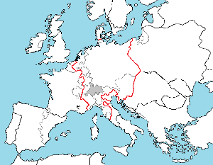THE SWISS CONFEDERATION IN 1525

Swiss Territory in 1525
From around 1000 AD what is now Switzerland was part of the Holy Roman Empire but towards the end of 13th Century the Swiss cantons of Uri, Schwyz, Unterwalden began to assert their independence from their feudal overlords. The Dukes of Hapsburg, Savoy and Burgundy repeatedly tried to bring their unruly Alpine territories back under their control but the Swiss developed a new style of warfare inspired by the phalanxes of Alexander the Great.
Throughout the Middle Ages the fully armoured, mounted knight was the master of the battlefield so the Swiss, who suffered from a severe shortage of war horses, armed their citizen infantry with 18 foot pikes, halberds and double handed swords. This created a hedge of sharpened steel points, which the noble mounted knights of the Hapsburg and Burgundian armies could not break, and soon the all-conquering Swiss were much in demand as mercenaries.
Swiss reisläufer guarded the king of France until the French Revolution, when they were massacred defending royal palace of The Tuileries, and the papal Swiss Guard still protects The Vatican. So successful were the Swiss pike squares, the Holy Roman Emperor Maximilian I created his infamous landsknechts in imitation of their highly successful tactics.The landsknechts and reisläufer became implacable enemies and no quarter was asked or given when they met in battle.
During the 16th Century the military supremacy of the Swiss declined but the cantons of Zurich, Berne, Lucerne, Uri, Schwyz, Unterwalden, Zug, Glarus, Basel, Fribourg, Solothurn, Schaffhausen and Appenzell all retained their hard won autonomy within the Holy Roman Empire. Finally, in 1648, the Peace of Westphalia which ended The Thirty Years War, granted The Thirteen Cantons of The Swiss Confederacy full independence from imperial rule.